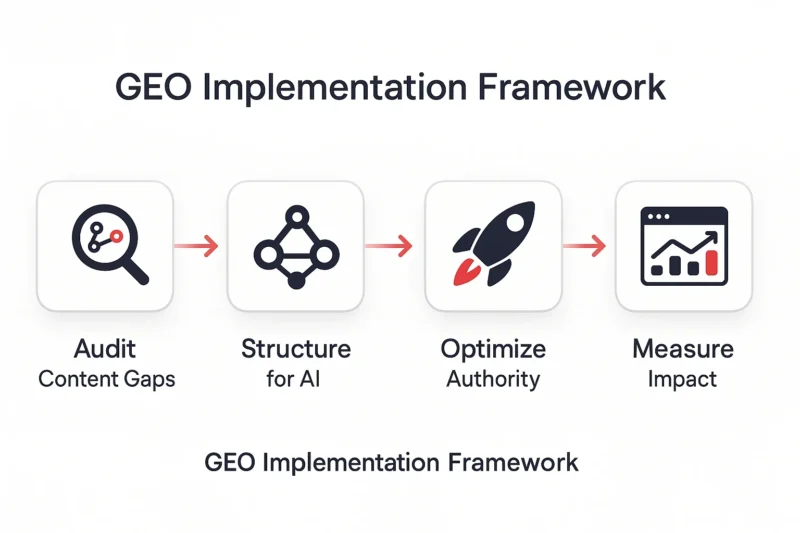How GEO Optimization Strategies Boost Brand Visibility
Website referrals from large language models increased by 800% year-over-year in just the past three months. This explosive growth signals a fundamental change in how consumers discover and engage with brands. And it’s happening faster than most marketing teams anticipated.
Traditional SEO strategies that dominated the past decade are quickly losing their effectiveness as AI-powered search engines like ChatGPT, Perplexity, and Google’s AI Overviews reshape the digital discovery process. With ChatGPT surpassing 400 million users as of February 2025, the opportunity for brands to capture this massive audience through Generative Engine Optimization (GEO) has never been more critical.
For marketing executives and operations managers at growth-stage companies, the question isn’t whether to invest in GEO–it’s how quickly you can implement strategies that deliver measurable ROI. The brands that master these optimization techniques today will secure a competitive advantage that compounds over time, while those that delay risk becoming invisible.
TABLE OF CONTENTS:
Key Takeaways
- GEO optimization strategies for brand visibility deliver exponential growth with website referrals from AI models increasing 800% year-over-year, making early adoption critical for competitive advantage
- Authority-driven content with citations boosts AI visibility by 30-40% compared to baseline content, requiring structured data, expert insights, and a comprehensive FAQ schema to maximize citation frequency
- Measure success through AI-specific metrics, including AI-Generated Visibility Rate (AIGVR) and AI Engagement Citation Rate (AECR), with top performers achieving higher AIGVR rates for core topics
- Cross-channel integration amplifies GEO results when brands maintain consistent entity references and messaging across video, podcasts, social media, and technical documentation
- Speed of implementation trumps perfect execution, where establishing authority signals early creates lasting competitive moats before markets become saturated
Understanding GEO’s Competitive Advantage in 2025
Generative Engine Optimization represents a strategic framework for ensuring your brand appears prominently in AI-generated responses across platforms like ChatGPT, Perplexity, Gemini, and other large language models. Unlike traditional SEO, which focuses on ranking in search results, GEO optimization focuses on citations and contextual relevance within AI-generated answers.
Smart Rent restructured their content to be AI-readable and fixed the technical SEO issues that prevented them from ranking. They recorded a 100% increase in citations on ChatGPT, Perplexity, and Gemini, in addition to a 50% lift on AI Overviews. This was transformative growth that directly impacted their bottom line.
“The brands investing in GEO today are building digital moats that become increasingly difficult for competitors to breach. It’s not just about visibility. It’s about establishing authoritative presence in the knowledge graphs that power AI responses.” – Industry Analysis, 2025
The urgency becomes clear when you consider that AI platforms are training on current web content, making today’s optimization efforts foundational for long-term brand visibility. Companies that delay GEO implementation risk missing this critical window where early adoption creates lasting competitive advantages.

Core GEO Strategies That Drive Measurable Results
Successful GEO implementation requires a systematic approach that prioritizes authority, structure, and semantic connectivity. The most effective strategies focus on making your content not just discoverable, but citable and contextually relevant within AI-generated responses.
Authority-Driven Content Optimization
Including authoritative citations and statistics in content boosts visibility in Generative AI Results compared to baseline content. This is about creating content that AI models recognize as credible and comprehensive.
Bierman Autism restructured the technical side of their website and improved Core Web Vitals to earn more AI citations. The result? 100% more citations in Gemini and 75% AI Overview capture.
The key lies in structuring authoritative content that serves both human readers and AI interpretation. This means creating content with clear hierarchies, definitive statements backed by data, and expert insights that establish authority within your industry vertical.
Structured Data and Semantic Connectivity
AI models favor content that demonstrates clear relationships between concepts, entities, and data points. Implementing a comprehensive FAQ schema, using consistent entity references, and creating content clusters around core business topics significantly improves your brand’s likelihood of being cited in relevant AI responses.
LS Building Products achieved this in their strategy. They implemented a full-funnel content strategy and created clusters of content around product categories to educate and convert customers. This drove a 229% increase in conversion rates.
| Optimization Strategy | Implementation Focus | Typical Results Timeframe | Measurable Impact |
|---|---|---|---|
| Authority Content | Expert-backed insights with citations | 3-6 months | 30-40% visibility increase |
| Structured Schema | FAQ and entity markup | 2-4 months | 15-25% citation improvement |
| Community Signals | User-generated validation | 1-3 months | 10-20% relevance boost |
| Data-Rich Research | Original studies and reports | 6-12 months | 50-100% authority gains |
Measuring GEO ROI and Attribution
Effective GEO strategies require sophisticated measurement approaches that go beyond traditional SEO metrics. The most successful implementations track three critical performance indicators: AI-Generated Visibility Rate (AIGVR), AI Engagement and Citation Rate (AECR), and direct traffic attribution from AI-mentioned brand searches.
AIGVR measures how frequently your content appears in AI-generated responses for relevant queries. Top-performing brands consistently achieve higher AIGVR rates for their core topic areas, indicating strong authority within AI knowledge bases. This metric directly correlates with brand visibility expansion and market share growth within digital discovery channels.
AECR tracks citation frequency and engagement depth when AI platforms reference your brand or content. High AECR scores indicate that AI models view your brand as authoritative and trustworthy, leading to increased organic mention rates and referral traffic. Companies with strong AECR performance often see compound growth effects as AI citations reinforce brand authority over time.
Revenue Attribution Methodologies
Direct revenue attribution from GEO efforts requires tracking branded search spikes following AI mentions, monitoring referral traffic from conversational AI platforms, and analyzing customer journey touchpoints where AI-generated content influenced purchase decisions. Many successful implementations see new customer acquisitions showing AI touchpoint influence within six months of comprehensive GEO deployment.
The measurement complexity demands sophisticated attribution modeling, but the ROI justification becomes compelling when you consider that AI-influenced traffic typically converts at a higher rate than traditional search traffic, due to the pre-qualified nature of AI-driven recommendations.

Advanced Implementation Tactics for Enterprise Growth
Enterprise-level GEO implementation requires sophisticated content architecture that supports scalable optimization across multiple product lines, geographic markets, and customer segments. The most effective approaches integrate GEO principles into existing content workflows while establishing new measurement and optimization processes.
Successful enterprise implementations often begin with comprehensive content audits that identify high-value optimization opportunities. This involves analyzing current content performance in AI-generated responses, mapping competitive positioning within AI citation networks, and prioritizing optimization efforts based on revenue impact potential and resource requirements.
Answer Everywhere Optimization frameworks provide scalable strategies for enterprise teams managing complex content portfolios across multiple channels. These approaches ensure consistent optimization standards while allowing flexibility for department-specific requirements and market variations.
Cross-Channel Integration Strategies
Advanced GEO implementations recognize that AI optimization extends beyond text-based content to include video transcripts, podcast descriptions, social media content, and technical documentation. Creating unified entity references and consistent messaging across all content channels amplifies your brand’s authoritative presence within AI knowledge bases.
The integration complexity requires dedicated project management and cross-functional coordination, but the compound effects justify the investment. Brands implementing comprehensive cross-channel GEO strategies typically see higher citation rates and stronger brand association metrics than those with single-channel optimization efforts.
Future-Proofing Your GEO Strategy Beyond 2025
AI continues evolving rapidly, with new platforms, capabilities, and optimization opportunities emerging quarterly. Future-focused GEO strategies emphasize adaptability, continuous learning, and proactive optimization rather than reactive adjustments to algorithm changes.
Forward-thinking organizations are investing in AI monitoring tools, establishing cross-functional GEO optimization teams, and creating systematic processes for testing and scaling successful optimization tactics. These investments position brands to capitalize on new AI platform launches, feature updates, and market opportunities as they develop.
The competitive advantage extends beyond immediate visibility gains to include long-term brand authority building within AI knowledge ecosystems. Brands that establish strong GEO foundations today will find it increasingly difficult for competitors to displace their authoritative positioning as AI platforms mature and stabilize their source preferences.
For marketing executives evaluating GEO investment priorities, the decision framework should emphasize speed of implementation over perfect execution. AI search rewards early movers who establish authority signals before markets become saturated with competitive optimization efforts.
Ready to transform your brand’s AI visibility and capture the expanding opportunity in generative search? Work with the leading GEO agency to develop and implement strategies that deliver measurable ROI while positioning your brand for sustained competitive advantage in the AI-first marketing landscape.
Ready to stop watching competitors dominate AI search while you’re still figuring out your strategy?
Related Video
Frequently Asked Questions
-
What makes GEO different from traditional SEO?
GEO focuses on optimizing for citation and contextual relevance within AI-generated answers, rather than ranking in search results. While SEO targets search engine rankings, GEO ensures your brand appears prominently in responses from AI platforms like ChatGPT, Perplexity, and Google’s AI Overviews.
-
How do you measure the success of GEO efforts?
Track three key metrics: AI-Generated Visibility Rate (AIGVR), AI Engagement and Citation Rate (AECR), and direct traffic attribution from AI-mentioned brand searches. Top-performing brands achieve higher AIGVR rates for their core topic areas, indicating strong topical authority within AI knowledge bases.
-
What are the most effective GEO optimization strategies?
Authority-driven content with citations boosts AI visibility by 30-40% compared to baseline content. Implement comprehensive FAQ schema, maintain consistent entity references, and create expert-backed insights with clear data tables and definitive statements that AI models recognize as credible.
-
How long does it take to see measurable results from GEO implementation?
Results vary by strategy: community signals show impact in 1-3 months, structured schema improvements appear in 2-4 months, and authority content typically delivers results in 3-6 months. Data-rich research and original studies may take 6-12 months, but can yield 50-100% authority gains.
-
Which tools and resources are essential for successful GEO implementation?
GEO requires AI monitoring tools, comprehensive content audit capabilities, and sophisticated attribution modeling to track AI-influenced traffic. Successful implementations also need dedicated project management and cross-functional coordination to maintain consistent optimization standards across multiple content channels.
-
How does cross-channel integration amplify GEO results?
Maintaining consistent entity references and messaging across video, podcasts, social media, and technical documentation amplifies GEO results. This comprehensive approach strengthens your brand’s authoritative presence within AI knowledge bases compared to single-channel optimization efforts.
-
Should companies prioritize speed or perfect execution when implementing GEO?
Speed of implementation trumps perfect execution. AI search rewards early movers who establish authority signals before markets become saturated, creating lasting competitive advantages that become increasingly difficult for competitors to breach.





